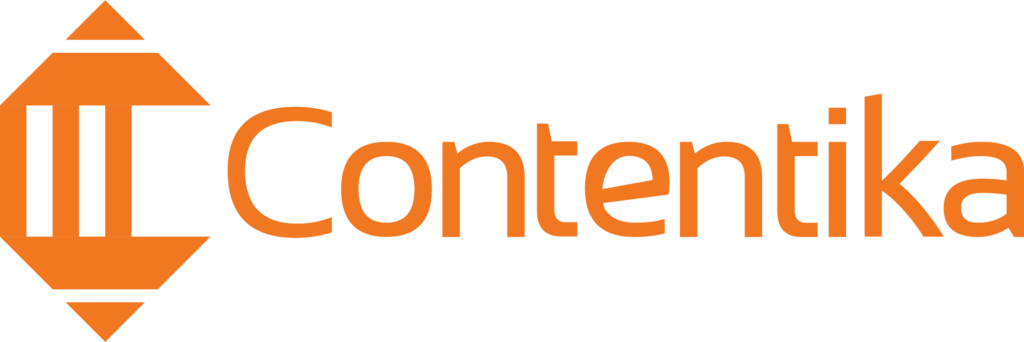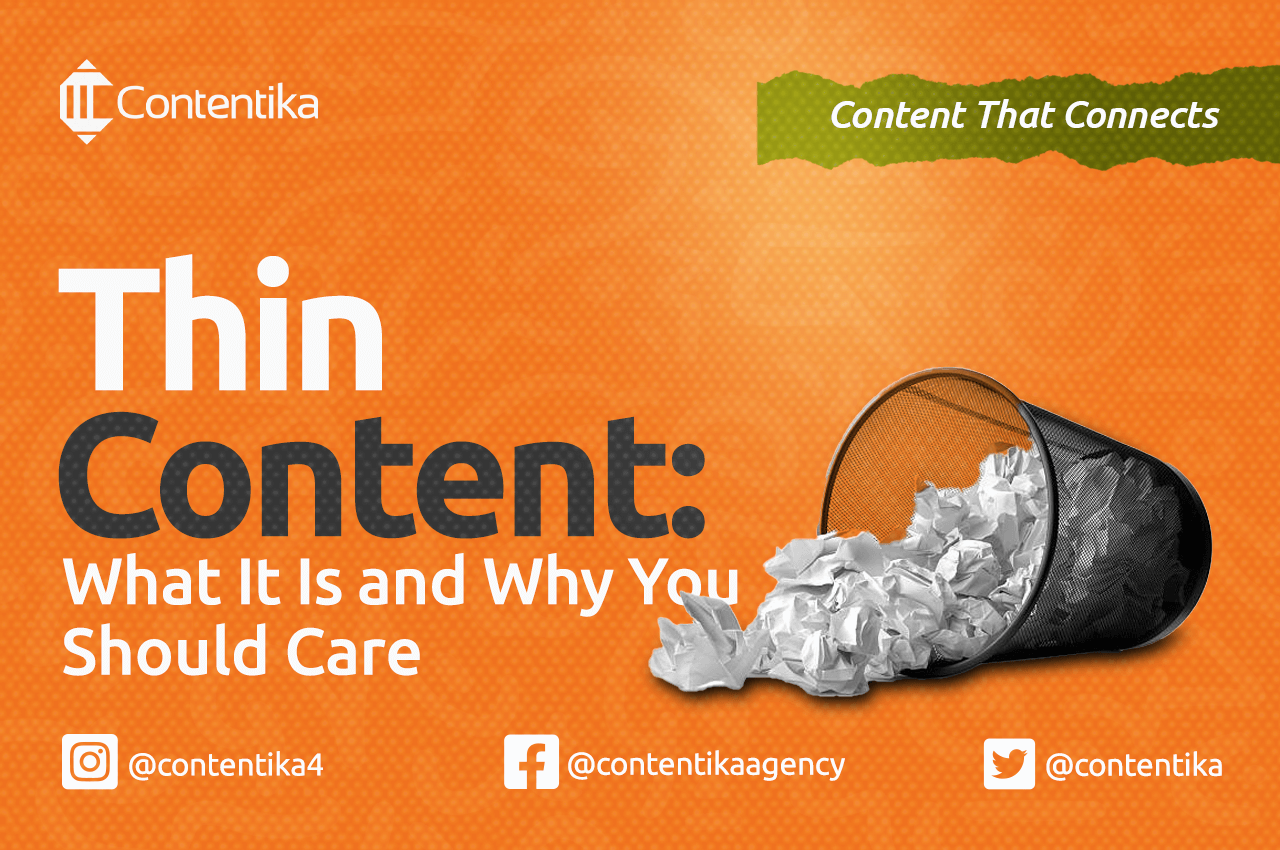Consumers are overwhelmed with ads and promotions. To stand out from the competition, you need to provide value and establish trust with your audience. Content marketing does just that, by creating useful and informative content that resonates with your target market.
As the Content Marketing Institute’s recent survey shows, more and more marketers are recognizing the value of this approach. With 67% of them acknowledging that content marketing generates demand and leads, and 63% seeing it as a way to build customer loyalty, it’s clear that content marketing is here to stay.

But where to begin? Our comprehensive guide covers everything you need to know to get started with content marketing, from attracting customers to converting them into loyal buyers. Discover the secrets of creating content that truly engages your audience and drives results for your business. With the right strategy in place, you’ll be on your way to content marketing success.
What is Content Marketing Strategy?
Content marketing strategy is creating and distributing valuable, relevant, and consistent content to attract and retain a clearly defined audience—and, ultimately, to drive profitable customer action.
Content creation is at the heart of content marketing. To do this, you should begin by defining your objectives. What goals or outcomes are you hoping to achieve through content marketing?
Do you want more leads, an increase in sales, higher engagement rates, and better brand recognition and awareness? Defining your objectives is the first step in creating a successful content marketing strategy.
Once you clearly understand your business objectives, you can create a content marketing strategy to help you achieve them. Your strategy should be an evolutionary process; as your business changes and grows, so should your strategy and content production.
Additionally, it should be integrated with other marketing initiatives (such as email marketing, social media marketing, and paid advertising) to amplify its impact.
While creating quality content is essential to success in content marketing, it’s only half the battle. You must also promote your content to ensure it reaches your target audience. There are various ways to do this, including through social media, email newsletters, search engine optimization (SEO), and paid advertising.
A well-executed content marketing strategy can help you achieve various business goals, including increased brand awareness, more leads, higher conversion rates, and more customers.
By developing a detailed and comprehensive strategy, you can set your business up for success and generate organic traffic to your site.
Objectives of Content Marketing
The objectives of content marketing can vary depending on the business, but there are some common goals. Typically, businesses use content marketing to generate leads, build brand awareness, or establish themselves as thought leaders in their industry. Additionally, many companies use it to drive traffic to their website or blog.
To achieve these objectives, businesses need to produce high-quality content that is relevant and interesting to their audience.
In addition, they need to ensure that this content is distributed through the appropriate channels, such as social media, email marketing, or paid advertising.
Why You Need a Content Marketing Strategy
Without a strategy, businesses will often waste time and money on campaigns that don’t achieve their desired results. But with a clear strategy in place, you can ensure that your content efforts are focused and effective.
A content marketing strategy will help you identify the right audience, create content that resonates with them, and measure success as defined by tangible objectives. It is essential for businesses to create an effective content marketing plan if they want to reach their desired targets and maximize their ROI.
A good marketing strategy also helps you differentiate yourself from competitors and stand out in a crowded marketplace.
By combining a strong content marketing strategy with an effective digital marketing plan, businesses can make sure that they are achieving maximum visibility and reach out to their ideal customers.
The Pillars of Content Marketing
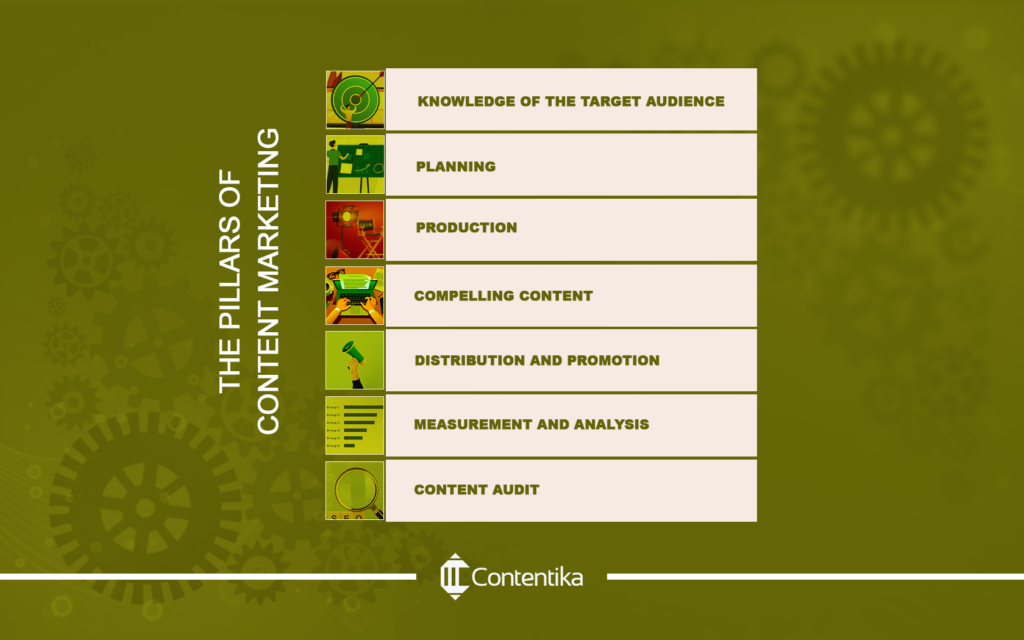
Any great content marketing strategy has certain key pillars supporting it. These pillars provide the framework that any successful content marketing strategy must have to be successful.
Knowledge of The Target Audience
An effective marketing campaign must stem from a thorough understanding of its target audience. Who are they? What are their needs and wants? What motivates them? Once you have answered these questions, you can develop a strategy for reaching and engaging your audience.
For example, if you know that your audience consists of working mothers, you might want to focus on creating ad campaigns that highlight the importance of time-saving products and services.
You might also consider placing ads where working mothers are likely to see them, such as in parenting magazines or near daycare facilities. Your content production should speak directly to the customer journey.
Taking the time to understand your audience helps your planning process and ensure that your marketing campaign is successful.
Planning
Planning is essential to content marketing. You need to clearly understand what you want to achieve before creating content. This means setting goals that resonate with your target audience.
Additionally, you need to have a plan for how you will create and distribute your content. This includes deciding which channels you will use to promote your content.
Finally, you need to establish metrics for measuring success. By taking the time to plan out your content marketing strategy, you can ensure that it is as effective as possible.
Production
Once you have a plan in place, it’s time to start producing content. This can be anything from memes and articles to videos and infographics.
When creating content, keep your audience in mind and make sure that the content is relevant and interesting to them. Additionally, make sure that the content is well-written and free of errors.
Whatever you choose, ensure the content is high quality and relevant to your audience and customer journey.
Compelling Content
Great content is the key to a successful website or blog. It’s what keeps people coming back for more, and it’s what drives traffic and engagement. But what exactly is “great content”? And how do you create it?
The content must be well-researched and accurate while also being interesting to read. A content team will often brainstorm ideas for new content production, research the topic, create content, and edit it before publication.
Creating compelling content can be challenging, but it is important to remember that the goal is to educate and entertain the reader. There are a few key elements that can help make content more compelling.
First, focus on creating how-to articles that are clear and concise. Second, use strong visuals to break up the text and add interest. Third, keep the content updated regularly so that readers always have something new to learn.
Distribution and Promotion
The third pillar is effective distribution and promotion. Even the best content will fail to deliver results if it cannot reach its intended audience. That’s why it’s important to have a plan for getting your content seen by those most likely to be interested in it.
A successful content strategy must include a comprehensive distribution plan, considering how people consume content. For example, you might distribute your content via email, social media, and RSS feeds.
You should also use paid promotion methods such as Google AdWords and native advertising to help your content appear in search engines.
Once you’ve created a distribution plan, the next step is to start promoting your content. This means creating eye-catching headlines, using effective calls-to-action, and crafting compelling copy that will encourage people to click through to your content.
You should also experiment with different content formats to see what gets the most engagement. For example, infographics or videos might work better in some cases than in a traditional blog post.
By taking the time to create a well-rounded distribution and promotion strategy, you can set your content up for success and ensure that it reaches the widest possible audience.
Measurement and Analysis
The final pillar is measurement and analysis. Without measuring your results, it’s impossible to know whether or not your content marketing strategy is working. Fortunately, there are several different metrics that you can use to track the success of your content.
The most important metrics to track include pageviews, unique visitors, time on site, social shares, and conversion rates. By monitoring these metrics, you can better understand which pieces of content are performing well and which need to be improved.
In addition to tracking general metrics, you should also perform A/B testing on your headlines, calls-to-action, and other elements of your website or blog. This will help you fine-tune your content and ensure it is as effective as possible.
By measuring and analyzing your results, you can ensure that your content marketing strategy is on track and making the impact you want.
Content Audit
A content audit is a detailed inventory of all the content on your website. This includes everything from the text on your web pages to your posted images and videos. Conducting a content audit can be time-consuming, but it is essential to understanding your content and how it can be used more effectively.
By taking stock of your content marketing assets, you can identify gaps and ensure that your website provides your audience with the most relevant and useful information. In addition, a content audit can help you streamline your content strategy and ensure that your website works efficiently.
How to Create a Great Content Marketing Strategy?
The best way to create a great content marketing strategy will vary depending on your business and goals. However, there are some key steps you can take to create a content strategy that will work for you:
Set Clear KPIs
It’s important to establish some metrics by which you can measure the success of your content marketing efforts. What counts as a conversion for you – a new newsletter sign-up, a product purchase, or something entirely else? By setting up clear KPIs from the start, you’ll be able to track whether or not your content has the desired effect.
With these steps in mind, you’re well on your way to crafting a successful content marketing strategy. By taking the time to establish your goals and develop a plan for how to achieve them, you’ll set yourself up for success.
Examine Your Current Position
This includes looking at the quantity and quality of your online content and assessing how well it aligns with your business goals.
Once you clearly understand your current position and industry trends, it’s time to start thinking about the various types of content you can create. Depending on your industry and goals, this could include everything from blog posts and infographics to eBooks and webinars.
The important thing is to focus on creating high-quality, original content to help you achieve your desired results. Remember, content marketing is all about providing value to your audience. You’ll be well on your way to success if you can do that.
Determine the Most Effective Content Channels
To start content marketing, businesses must determine which content channels will most effectively reach their targeted audience.
Depending on the products or services being promoted and the audience’s needs, wants, and preferences, some content channels may be more effective than others.
Once the most effective content channels have been identified, businesses can create a calendar outlining when and where content will be published.
Develop Buyer’s Persona
Another key element of successful content marketing is developing buyer personas. Buyer personas are fictional representations of ideal customers based on real data and market research.
When constructing buyer personas, consider factors such as age group, job title, income level, interests, and hobbies.
Knowing what makes each persona unique will help you determine the types of stories or topics they might be interested in, as well as what type of language or tone you should use.
By creating detailed buyer personas, businesses can better understand their potential buyers’ pain points and produce content that addresses those needs.
Choose Content Types
You can create many types of content, but not all types will be a good fit for your business. You must choose content types that align with your business goals and audience needs. For example, if you want to generate leads, blog posts might not be the best option; instead, you could create a downloadable PDF or an email course.
On the other hand, if you want to build relationships with your customers, a funny video might be just what you need. The important thing is to experiment and create content that aligns with your business. There is no one-size-fits-all solution when it comes to content marketing.
Determine and Allocate Resources
Creating a great content marketing strategy also involves a clear understanding of the available resources. This means taking stock of the human (content team) and financial resources at your disposal.
Once you have a sense of what you have to work with, you can start to allocate those resources in a way that will most effectively support your content marketing goals. For example, if you have a limited budget, you may need to focus on creating lower-cost content like blog posts or infographics.
Alternatively, if you have a team of experienced writers, you may decide to invest in developing more in-depth pieces like ebooks or whitepapers. Using your resources to best align with your overall content marketing strategy is key.
By taking the time to determine and allocate your resources upfront, you can set yourself up for content marketing success.
Make a Content Schedule
A content schedule helps to create a steady stream of fresh, relevant content that will resonate with your audience. It also helps keep you organized so you don’t get overwhelmed or bogged down in the details.
While there is no perfect formula for creating a content schedule, a few simple steps can help you get started. First, take inventory of the types of content you have and the frequency with which you want to publish new pieces.
Next, create an editorial calendar that outlines when each piece of content will be published. Finally, make sure to leave some flexibility in your schedule to allow for unexpected opportunities or changes in direction. Following these simple steps, you can develop a content schedule to keep your content marketing efforts on track.
Create Content
Content creation could be anything from blog posts and articles to infographics and videos. The important thing is that your content is original and informative. It should also be shareable, so include social media buttons on your website or blog.
Creating content may take a bit of extra effort, but it’s worth it if it means attracting more visitors to your site.

There are several ways to distribute, promote, and market your content. One of the most effective techniques is creating social media posts highlighting your content and including links to your website or blog.
You can also share your content on social media channels such as Facebook, Twitter, and LinkedIn. In addition, several digital tools can help you promote and market your content, such as Hootsuite, BuzzSumo, and Google Analytics. Using these tools, you can reach a larger audience and engage more people with your content.
Implementing Automation
Automation allows businesses to scale and grow by freeing up valuable resources that can be used elsewhere. With automation, you can create more personalized customer experiences and target them with relevant content tailored for their needs.
Additionally, automation can help you monitor the performance of your content, allowing you to make necessary changes in order to optimize results. Automation also allows businesses to quickly create and publish more content while simultaneously managing their social media channels.
Automating processes such as lead generation, email outreach, and customer service can save time and money while increasing productivity. Implementing automation into your content strategy allows you to maximize efficiency while delivering high-quality content that engages customers and drives conversions.
Types of Content Marketing (Content Format)
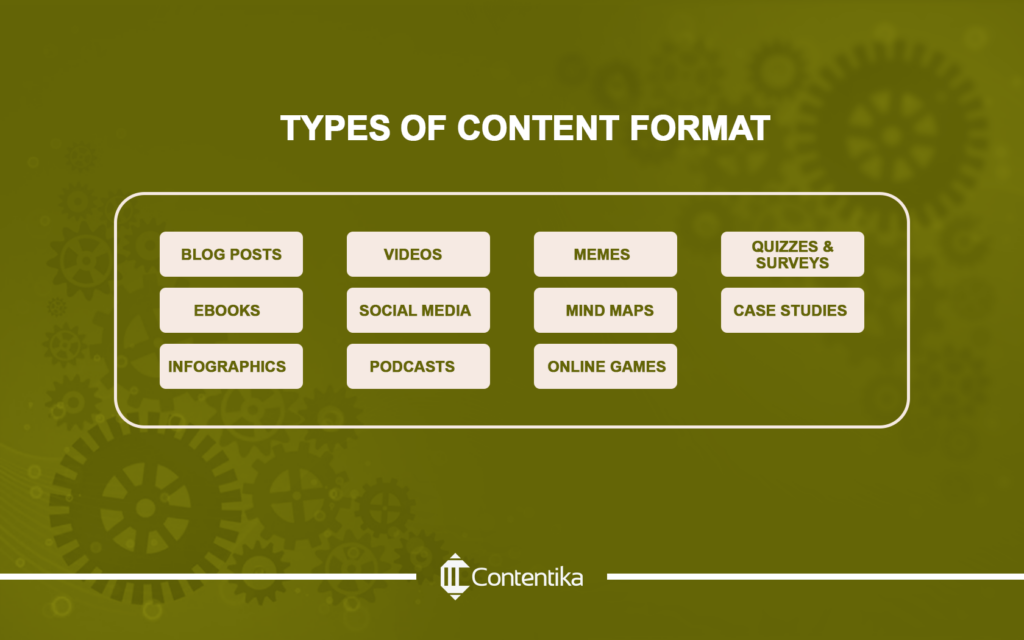
Blog Posts
Blog posts are a type of content marketing. A blog post is simply an article on a website, typically published in reverse chronological order. The purpose of a blog post is to give readers timely information that is relevant to them in an engaging and compelling way.
However, blog posts can also be used to promote products or services. For example, a blog post could be used to review a product or promote a sale. In addition, blog posts can be used to build customer relationships or generate sales team leads. Ultimately, blog posts are a flexible and powerful tool that can be used for various content marketing goals.
Ebooks
If you post written content, then ebook marketing should be a no-brainer. After all, ebooks are a type of content marketing.
Ebooks can be either physical books or digital versions of the same, and they can be used as a powerful tool for lead nurturing.
They can be used as lead generation tools, as gated content on your website, or as part of an email marketing campaign.
And because they’re digital products, they can easily be shared with potential customers via social media or email. So ebooks should be part of your marketing mix if you’re looking for a cost-effective way to reach your target market with valuable content.
Infographics
Infographics are a type of content marketing that can effectively reach and engage your target audience. By providing valuable information in a visually appealing format, infographics can help you communicate your message more clearly and effectively.
In addition, infographics are highly shareable, making them an excellent way to build buzz and generate leads. If you’re looking for a way to take your content marketing to the next level, consider using infographics. They’re sure to engage and inspire your audience with their unique mix of visual appeal and informative value.
Case Studies
Case studies tell the story of how a customer used a product or service to solve a problem or overcome an obstacle. Unlike other forms of marketing, case studies are less about selling and more about educational value.
They can be very compelling and help customers understand the potential of a product or service. Case studies can also be an effective way to build trust and credibility with potential customers.
Because they are based on real-world examples, they provide an element of authenticity that can be lacking in other forms of marketing.
Videos
Video content marketing is effective for several reasons. First, it’s highly engaging and entertaining, which makes it more likely to hold viewers’ attention than other types of content. Second, it’s very shareable, so it has the potential to reach a broad audience.
And third, it can be highly persuasive, making it an effective tool for promoting products and services. There are several ways to use video content marketing, from creating promotional videos to producing educational content. No matter what approach you take, video content marketing can be an extremely effective way to promote your business.
Social Media
Businesses can reach many potential customers with minimal effort by sharing engaging and informative content on social media platforms like Facebook, Twitter, and Instagram. In addition, social media provides businesses with an excellent way to personally connect with their buyers.
Through regular posts and interaction with followers, businesses can build relationships with potential and current customers that promote loyalty and brand awareness. In short, social media is essential for any business that wants to succeed in the modern marketplace.
Podcasts
Podcasts are content marketing that involves regularly creating and releasing audio episodes. Each episode usually has a specific theme or topic and can range in length from a few minutes to an hour or more. Podcasts can be released either as part of an existing website or blog or as a standalone product.
When done well, podcasts can be an extremely effective form of content marketing, providing listeners with valuable information while also building rapport and trust.
And because they can be consumed while commuting, working out, or doing other activities, podcasts offer a high level of engagement.
Quizzes and Surveys
Content marketing can take many forms, from blog posts and e-books to infographics and webinars. But one often overlooked type of content marketing is quizzes and surveys. When done well, quizzes and surveys can be a great way to engage your audience, generate leads, and even promote your brand.
However, quizzes and surveys can be spammy or dull when done poorly. So how can you ensure that your quizzes and surveys are successful? Here are a few tips:
- Keep it short and sweet. No one wants to spend hours filling out a quiz or survey, so make sure yours is concise and to the point.
- Make it relevant. Your quiz or survey should be relevant to your brand and audience. Don’t try to force a fit – if it doesn’t make sense, ditch it.
- Add an element of fun. A little humor can go a long way in making your quiz or survey more engaging. Don’t overdo it – you don’t want to come across as try-hard or unprofessional.
- Get creative with the format. There’s no need to stick with the traditional multiple-choice format – get creative and mix things up a bit!
- Offer something valuable. Incentivize people to take your quiz or survey by offering something valuable, like a discount code or an entry into a giveaway.
By following these tips, you can ensure that your next quiz or survey is successful!
Memes
In recent years, memes have become increasingly popular online content. What started as a way to share funny pictures and videos between friends has become a powerful marketing tool. Memes offer a unique way to reach and engage with potential customers.
They are often shareable and can go viral quickly, resulting in a wide reach for very little investment. Additionally, memes tend to be relatable and entertaining, which can help create a positive association with your brand.
Mind Maps
A mind map is a type of content marketing used to increase brand awareness and boost engagement. Mind maps are visual representations of ideas or concepts. They can be used to brainstorm content ideas, promote existing content, or even just provide a fun and creative way for people to learn about your brand.
Mind maps are usually created using software such as Adobe Illustrator or Photoshop, but they can also be hand-drawn. The key to creating a successful mind map is to make it visually appealing and easy to understand.
Mind maps should be clear and concise, with each idea represented by a simple image or icon. In addition, mind maps should be easy to navigate so that viewers can quickly find the information they are looking for.
Newsletters
Newsletters are content marketing tools used to cultivate relationships with potential and current customers. However, crafting an effective newsletter takes time and effort.
A few key elements should be included in every newsletter, such as a catchy headline, helpful articles, eye-catching images, and a call to action. Additionally, it is important to ensure that your newsletter is consistent with your brand voice.
Taking the time to create a well-crafted newsletter helps build trust and credibility with your audience while also driving results for your business.
Illustrations
A picture is worth a thousand words, and that’s especially true when it comes to marketing. Illustrations can help break up a text, make complex concepts more understandable, and add a touch of personality to your brand.
In addition, illustrations can be highly shareable on social media, making them an effective tool for content marketing. They must be well-designed, relevant to your audience, and in line with your brand voice to be truly effective.
Online Games
Online games are a form of content marketing that has grown in popularity in recent years. Unlike traditional forms of advertising, online games do not rely on interruptions to grab attention.
Instead, they provide an entertaining experience that can capture an audience’s attention and persuade them to try a product or service.
American fast-casual restaurant chain, Chipotle, published a memory-based game, “A Love Story, in 2016. This game was created as a sequel to their animated short film of the same name. It was a huge success. Also, Chipotle offered players a buy-one-get-one-free meal promotion that was only available online, which they could redeem at any Chipotle location in the United States or Canada.
Games can also be used to build brand awareness or promote a new product launch to new and existing customers.
Additionally, online games offer a unique opportunity to collect data about player behavior. This data can be used to improve the game itself or to inform future marketing campaigns.
Adverts and Content Marketing
There’s no doubt that content marketing is one of the most effective ways to reach your target audience. But what about ads for content marketing? Are they worth the investment?
The short answer is yes! Ads for content marketing can be extremely effective, provided they are well-targeted and well-crafted.
Regarding targeting, consider your target audience’s demographics, interests, and needs. This will ensure that your ad reaches the right people. When crafting, remember to keep your ad simple, clear, and engaging. A little humor can also go a long way toward making your ad stand out from the rest.
If you’re looking for a way to take your content marketing to the next level, ads are worth considering. You can include keyword research to determine the key terms for improved Search Engine Optimization (SEO) and search ranking. With the right approach, they can be a powerful tool for driving traffic and increasing conversions.
Types of Adverts for Content Marketing
Sponsored Posts
A sponsored post is a social media post that a brand or influencer has paid for, typically on Instagram. The purpose of a sponsored post is to promote a product or service. A sponsored post is a type of user-generated content and can be in the form of photos, videos, or even just text.
Typically, an influencer will tag the brand in their post and include a brief description of the product or service. Sponsorships are a great way for brands to reach a wider audience and authentically promote their products or services. And, for influencers, sponsorships provide an opportunity to generate income while promoting products or services they believe in.
Native Advertising
Native advertising is a form of advertising that is specifically designed to look like natural editorial content. It is often used on social media platforms and websites and is intended to be less intrusive than traditional banner ads.
Unlike banner ads or pop-ups, native ads are less intrusive and more likely to be clicked on by users. As a result, native advertising has become one of the most popular forms of online advertising in recent years.
So how does native advertising work? Native ads are typically displayed as sponsored content or in-feed advertisements on social media platforms like Facebook, Twitter, and Instagram. They can also be found on websites, apps, and email newsletters. When placed next to other relevant content, native ads are more likely to be seen and interacted with by users.
Branded Content
Branded content is a piece created by a company or organization to promote its product or service. The content can take many forms, from blog posts and articles to videos and infographics.
One of the key benefits of branded content is that it allows companies to control the message they are trying to communicate. By creating their content, companies can ensure that the information they share is accurate and on-brand.
Additionally, branded content can be an effective way to reach new audiences. By sharing compelling and engaging content, content marketers can attract new readers and viewers who may not be familiar with their brand. Ultimately, branded content is essential for companies looking to market their content.
By taking the time to plan and execute a contest properly, businesses can reap the many benefits that this marketing strategy has to offer.
Tips For Creating Your Advert Effectively
When it comes to content marketing, one of the most important things you can do is create compelling and professional-looking ads. Here are a few tips to help you get started:
- Keep it simple. Your ad should pass its message across at a glance. Use clear and concise language, and avoid using jargon or complex concepts. You also must ensure that the ad is well-designed and easy to understand. It should grab attention and be memorable without being too overwhelming.
- Make it visually appealing. Use high-quality images or videos that capture people’s attention and convey your message.
- Write a catchy headline. Your headline should be attention-grabbing, making people want to learn more about your product or service.
- Call to action. Don’t forget to include a call to action in your ad, telling people what you want them to do (e.g., “click here to learn more”).
- Test, test, test. Try out different versions of your ad to see what works best. A/B testing is a great way to do this.
Following these tips can help you create a compelling and professional-looking advertisement for your content marketing campaign.
How To Measure The Success Of Your Advert Campaign
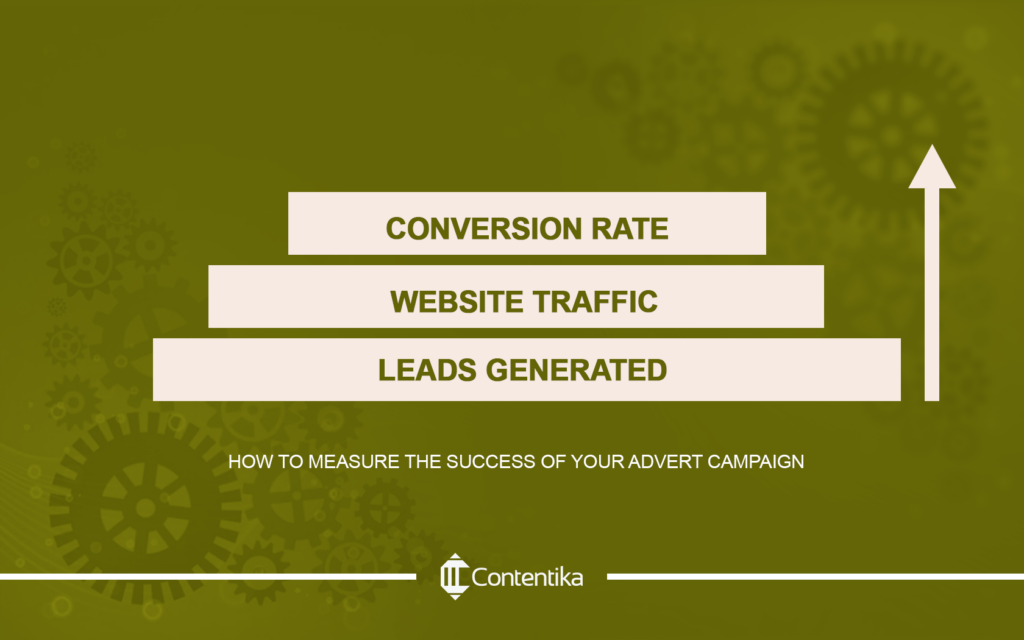
You can measure a few key things to determine the success of your advertising campaign. First, look at the number of leads generated. This includes both online and offline leads. If you see an increase in leads, it’s a good sign that your campaign is working.
Second, take a look at your website traffic. Again, if you see an increase in traffic, it means people are responding to your ads. Finally, check your conversion rate. This is the percentage of people who take the desired action, such as making a purchase or signing up for a newsletter.
More people will follow through on your call to action if your conversion rate increases. By tracking these key metrics, you’ll be able to tell whether or not your ad campaign is successful.
Final Thoughts
Congratulations! You have made it to the end of our content marketing guide! By now, you know that content marketing is a game-changer for businesses of all sizes. It’s not just about promoting your products or services, but about creating a connection with your audience by providing them with valuable and relevant information.
As you begin to implement your own content marketing strategy, keep in mind that it takes time and effort to see results. But don’t be discouraged! With patience and creativity, you can build a loyal following and drive traffic to your website.
Remember to experiment with different types of content and platforms to see what works best for your business. And most importantly, have fun with it! Content marketing allows you to showcase your brand’s personality and connect with your audience on a deeper level.
So go ahead and get started on your content marketing journey. With the tips and strategies we’ve shared, you’re sure to create a successful strategy that delivers results and keeps your audience coming back for more.
